The Philippines is home to numerous unique festivities that showcase its rich cultural heritage. The Obando Fertility Rites, Baliw-Baliw Festival, and Taong Putik Festival are examples of these lesser-known celebrations. These festivals highlight the blend of indigenous and Spanish influences that define Filipino culture.
One notable aspect of these festivities is their distinct blend of traditional and cultural practices. For instance, the Obando Fertility Rites involve dancing and song rituals to honor the town's patron saints.
In contrast, the Baliw-Baliw Festival features cross-dressing and comedic performances. Meanwhile, the Taong Putik Festival involves participants covering themselves in mud to symbolize their devotion to Saint John the Baptist.
These festivals not only promote community bonding but also emphasize the importance of preserving cultural roots. By participating in or witnessing these events, one can gain a deeper understanding of the Filipino spirit and culture.
Preserving traditions and cultural roots is crucial in maintaining a strong sense of community and identity.
Unique Filipino Celebrations
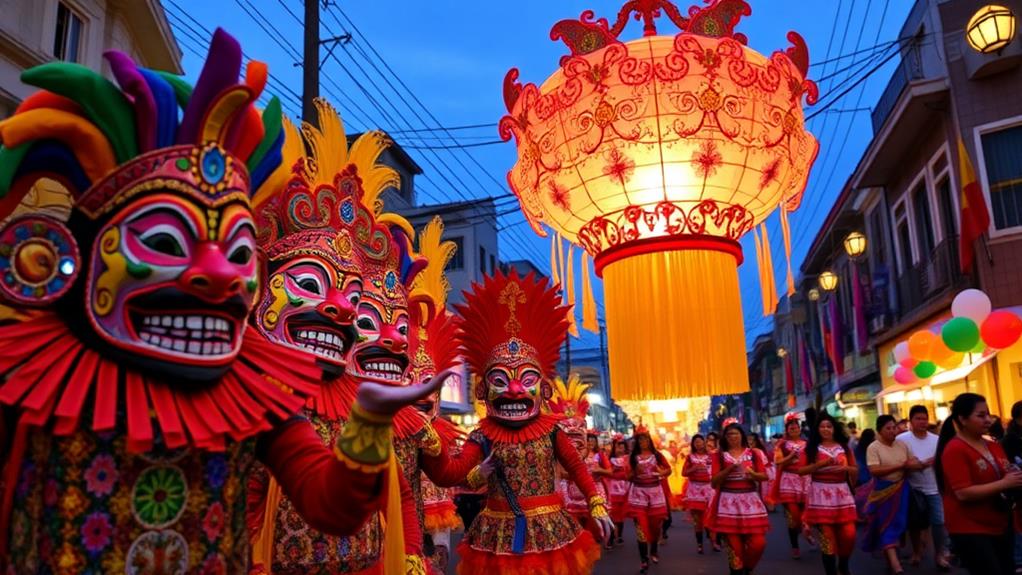
Unique Filipino celebrations showcase the country's rich cultural heritage, blending spirituality, tradition, and community participation.
Filipino celebrations often draw inspiration from patron saints. The Obando Fertility Rites in Obando, observed from May 17-19, are a prime example, where locals perform dance and song rituals to pray for fertility and health.
Another celebration that highlights community participation and cultural expression is the Baliw-Baliw Festival in Olango, which honors San Vicente Ferrer with unique rituals that include cross-dressing men and animal fights.
The Philippines has many other unique celebrations that reflect the local culture. The Taong Putik Festival in Aliaga features participants dressed in mud and leaves, while the San Pedro Cutud Lenten Rites involve devotees being crucified as penance during Holy Week.
Other notable celebrations include the Turogpo Festival in Leyte, which showcases traditional carabao fights, emphasizing the importance of teamwork and camaraderie in the community.
Festivals and Cultural Significance
The Philippines' numerous festivals significantly shape the country's identity and heritage.
Festivals often center around patron saints, reflecting the strong influence of Catholicism in Filipino culture. This is evident in events like the Sinulog and Ati-Atihan festivals, which attract millions of visitors each year.
These festivals showcase the country's rich cultural heritage in several ways:
- Festivals preserve traditions by engaging locals and tourists in traditional practices rooted in historical narratives and community spirit. The Taong Putik Festival is an example, where locals and tourists participate in traditional practices together.
- Cultural festivals serve as a platform for fostering community bonds. Activities such as street dancing competitions and culinary contests promote unity and cooperation among community members.
- Festivals stimulate local economies through tourism, engage farmers in agricultural showcases, and promote sustainable practices. The Banana Festival is an example, where festivals contribute to the local economy and promote sustainable agricultural practices.
Exploring Local Traditions
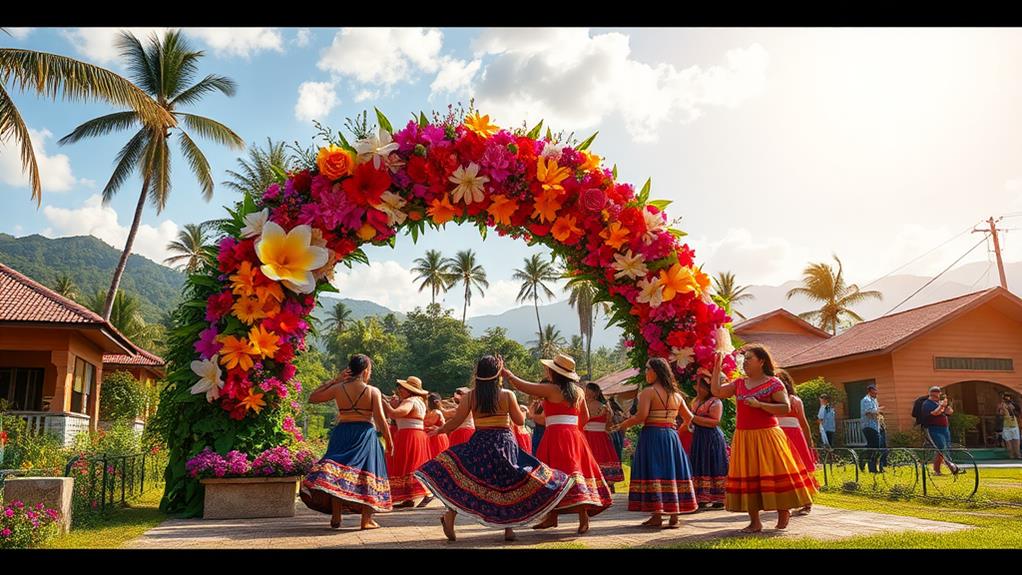
The Philippines boasts a rich cultural heritage, with numerous local traditions that highlight the Filipino people's creativity and resilience. Local festivals and customs play a significant role in showcasing this heritage.
Beyond grand festivals, the country has unique customs and practices worth exploring. For example, the Banana Festival in Baco highlights sustainable farming practices, while the Turogpo Festival in Leyte emphasizes teamwork and camaraderie through traditional carabao fights. These festivals demonstrate the importance of community and environmental awareness in Filipino culture.
Other local traditions offer insight into the country's deep cultural and religious practices. The San Pedro Cutud Lenten Rites are a prime example, showcasing the Filipino people's devotion during Holy Week. Meanwhile, the Obando Fertility Rites feature dance and song rituals that highlight the region's deep-rooted customs.
These traditions underscore the significance of faith and tradition in the Filipino way of life. Exploring these local customs provides a deeper understanding of the Filipino people's values and way of life.
Each tradition offers a glimpse into the country's complex cultural landscape, making them a fascinating aspect of the Filipino experience. By examining these customs, one can gain a broader understanding of the Philippines' rich cultural heritage.
Vibrant Arts and Entertainment
The Philippines' diverse arts and entertainment scene is reflected in numerous festivals throughout the year.
These festivals showcase music, dance, and interactive art installations, promoting cultural appreciation and entertainment.
Some notable festivals include the Wanderland Music and Arts Festival, the Malasimbo Lights and Dance Festival, and the International Reggae Festival.
The Wanderland Music and Arts Festival features a fusion of indie music and interactive art installations.
The Malasimbo Lights and Dance Festival showcases funk, hip-hop, and electronic music while promoting eco-tourism.
The International Reggae Festival celebrates both local and international reggae artists while fostering cultural appreciation and community engagement.
Beyond music festivals, the Philippines also hosts beauty pageants and traditional games that highlight the country's rich cultural heritage.
The Turogpo Festival, for instance, features traditional games and sports, while the Baliw-Baliw Festival showcases unique rituals that represent local culture.
These events offer a glimpse into the Philippines' vibrant arts and entertainment scene.
Filipino Food and Cuisine
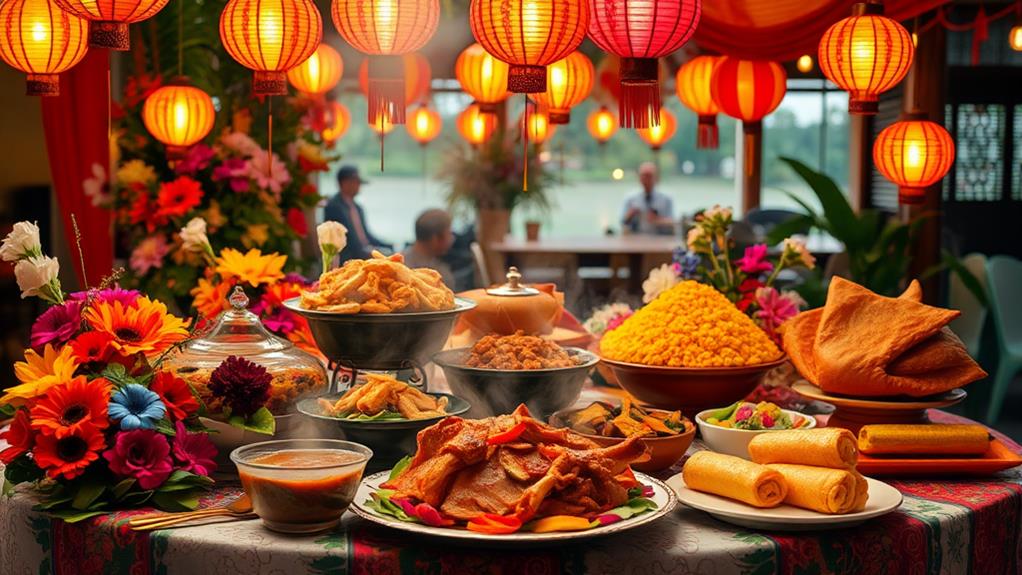
Filipino cuisine is a unique blend of Malay, Chinese, Spanish, and American flavors. This cultural diversity is reflected in the country's various dishes, such as adobo, kare-kare, and sinigang.
Rice is a staple in every meal, often accompanied by traditional side dishes like bagoong (fermented shrimp paste) or pickled vegetables.
Festivals showcase the best of local cuisine. Street food like lechon (roast pig), lumpia (spring rolls), and halo-halo (a mixed dessert) are highlights of culinary tourism.
The concept of "kamayan," or eating with hands, is a cherished tradition in Filipino culture, emphasizing communal dining experiences and the importance of sharing food among family and friends.
Each region in the Philippines boasts its own signature dishes and flavors. This diversity makes each festival a culinary journey to look forward to.
Regional Festivals to Visit
The Philippines' vibrant festival season showcases the country's diverse culture and rich heritage through various regional celebrations.
Each region boasts its own unique traditions and customs. These unique customs make every festival a one-of-a-kind experience.
Regional festivals offer opportunities to experience the country's diverse culture.
You can revel in the festive atmosphere, indulge in local delicacies, and participate in the merriment.
Regional festivals to visit include:
- Parada ng Lechon in Batangas is a celebration of culinary tourism and local traditions. It takes place on June 24 during the San Juan feast day, featuring a vibrant parade of elaborately decorated roasted pigs.
- The Banana Festival in Baco promotes sustainable practices and engages local farmers. Celebrated on March 18-19, this festival showcases various banana types through cook-fests, street dancing, and culinary exhibits.
- Malasimbo Lights and Dance Festival in Puerto Galera attracts participants from over 30 countries. This electronic music festival, which takes place from March 24-26, promotes eco-tourism and environmental conservation.
History Behind the Celebrations
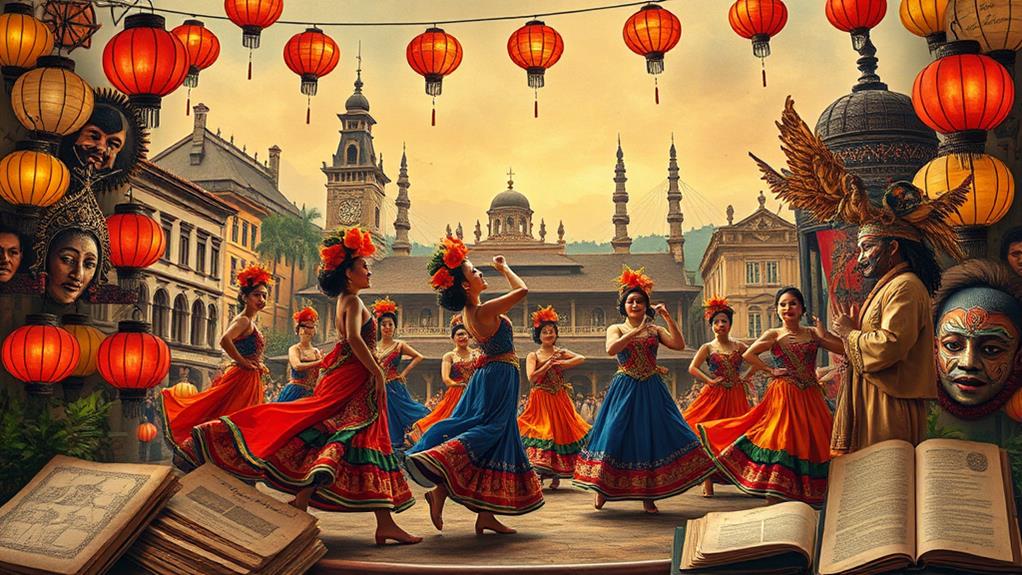
The Philippines' cultural heritage is rooted in its festival scene, which reflects its complex evolution.
The country's vibrant festivals have origins that date back to pre-colonial traditions, significantly influenced by Spanish colonization. This blending of cultures resulted in unique celebrations that integrate indigenous and Catholic practices.
Many festivals, such as the Sinulog and Ati-Atihan, commemorate historical events or the introduction of Christianity to the Philippines. These events showcase the fusion of local customs and Catholicism. For example, the Sinulog Festival in Cebu City celebrates the arrival of Christianity in the Philippines, while the Ati-Atihan Festival in Kalibo, Aklan, honors the arrival of Malay datus in the island of Panay.
The Turogpo Festival, on the other hand, celebrates local matchmaking traditions and highlights the agricultural practices that have been part of Filipino life for centuries. This festival in Caraga, Davao Oriental, demonstrates the importance of agriculture in the country's culture.
Other events, like the San Pedro Cutud Lenten Rites, demonstrate deep-rooted spiritual beliefs that date back to the Spanish colonial era. Participants engage in dramatic reenactments of penance, showcasing the country's strong Catholic faith.
What are some unique Filipino festivals that I can fully immerse myself in?
Experience the vibrant culture and rich traditions of the Philippines by immersing in Philippine festivals. Join the Ati-Atihan Festival in Aklan for colorful parades and street dancing. Witness the Panagbenga Festival in Baguio with its stunning flower floats. Or celebrate the Sinulog Festival in Cebu with its lively processions and religious rituals. immerse in philippine festivals and create unforgettable memories.
Why You Should Attend
Filipino festivals offer an unparalleled opportunity to immerse yourself in the country's rich cultural heritage, vibrant traditions, and warm hospitality. These celebrations showcase the country's history and values.
Experience a unique cultural heritage by attending festivals like the Wanderland Music and Arts Festival, which features a fusion of music and arts, or the San Pedro Cutud Lenten Rites, known for its dramatic Lenten rites.
Attending Filipino festivals also allows you to engage with local communities. For example, the Turogpo Festival features traditional games that you can participate in, while the Baliw-Baliw Festival showcases unique rituals and community participation.
One of the highlights of Filipino festivals is the opportunity to indulge in local cuisine. You can savor local delicacies and drinks while enjoying the festivities, which are often centered around food.
Filipino Festivals Around World
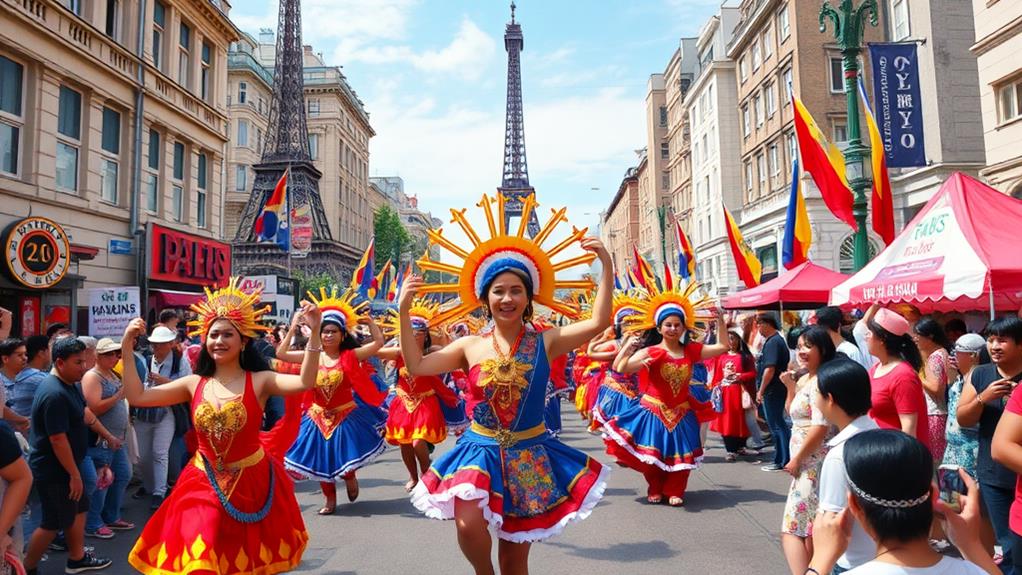
Filipino Festivals Celebrated Globally
Filipino communities around the world celebrate vibrant festivals that showcase the Philippines' rich cultural heritage. These events weave traditional Filipino customs into the fabric of international festivals.
Examples of Filipino Festivals Around the World
| Festival Name | Location | Description |
|---|---|---|
| Sinulog Festival | Cebu, Philippines; Toronto, Canada; New York, USA | Honors the arrival of Christianity in the Philippines, specifically the devotion to the Virgin Mary. |
| International Reggae Festival | Manila, Philippines | A fusion of Filipino and reggae music, promoting cultural diversity and artistic expression. |
| Parada ng Lechon | various locations | Showcases the country's culinary traditions through a roasted pig parade. |
| Obando Fertility Rites | Obando, Philippines; San Francisco, USA | Reinforces family bonds and cultural practices by connecting Filipinos worldwide to their ancestral customs.
The Significance of Filipino Festivals
These festivals promote cultural diversity and create a sense of unity among Filipinos worldwide. By attending these events, one can gain a deeper understanding of the Philippines' rich cultural heritage and the people's love for celebration and tradition.
Questions and Answers
What Is the Most Unique Festival in the Philippines?
The Philippines has numerous unique festivals, each showcasing its diverse cultural heritage. Two of the most notable ones are the Taong Putik Festival and the San Pedro Cutud Lenten Rites.
The Taong Putik Festival, celebrated in the town of Aliaga, Nueva Ecija, features participants covering themselves in mud and wearing vines and leaves. This festival honors Saint John the Baptist and is a unique display of devotion and faith.
The San Pedro Cutud Lenten Rites, on the other hand, is a reenactment of the crucifixion of Jesus Christ, with actual nailing of participants to a cross. This dramatic and intense display of faith is held in the town of San Pedro Cutud, Pampanga, during the Lenten season.
Why Is It Important to Learn About the Philippine Festivals?
Learning about Philippine festivals is essential for gaining cultural appreciation. Philippine festivals showcase the country's rich heritage and unique traditions. By understanding these festivals, you can appreciate the community spirit that brings people together and shapes Filipino identity.
For example, the Sinulog Festival in Cebu celebrates the country's Christian heritage, while the MassKara Festival in Bacolod showcases the city's vibrant culture through colorful costumes and masks. These diverse influences, including Spanish, American, and indigenous traditions, have shaped the Filipino identity and are reflected in various festivals throughout the country.
Why Shouldn't You Visit the Philippines?
You shouldn't visit the Philippines if you have misconceptions about its culture. Some people assume all areas of the country are unsafe due to high crime rates in certain cities like Manila. However, this is not entirely true. The Philippines has many safe and tourist-friendly destinations, such as Boracay and Cebu, known for their beautiful beaches and vibrant culture.
Another misconception is that the Philippines is underdeveloped. Although the country does face some economic challenges, it has made significant progress in recent years. The Philippines has a growing economy, with modern cities like Bonifacio Global City in Metro Manila, featuring sleek skyscrapers, shopping malls, and world-class restaurants.
Visiting the Philippines with these misconceptions can lead to unrealistic expectations and a biased experience of the country's rich culture. By understanding the reality of the Philippines, you can have a more enjoyable and authentic experience during your visit.
What Is Something Unique About Filipino Culture?
Filipino culture is a unique blend of various influences. This cultural diversity is a result of the country's history, with the Malay, Spanish, American, and Chinese influences shaping its identity. For example, the country's traditional clothing, such as the Barong Tagalog and the Terno, reflects a mix of Spanish and Malay designs. Similarly, Filipino cuisine, such as Adobo and Lechon, shows a blend of Spanish and Chinese flavors. This rich cultural diversity is also reflected in the country's vibrant traditions, customs, and warm hospitality.